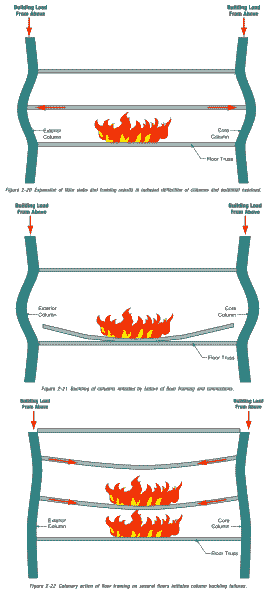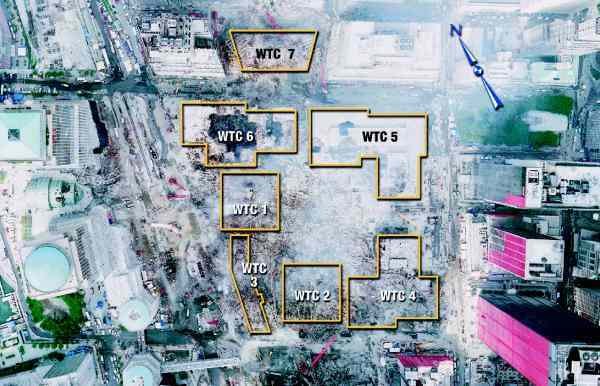11 сентября 2001, стр. 59
• As floor framing and supported slabs above and in a fire area are heated, they expand. The people who designed the towers were not fools and knew all this. They designed the towers to survive much more serious fires than those that occurred on September 11. As a structure expands, it can develop additional, potentially large, stresses in some elements. If the resulting stress state exceeds the capacity of some members or their connections, this can initiate a series of failures (Figure 2-20).

• As the temperature of floor slabs and support framing increases, these elements can lose rigidity and sag into catenary action. As catenary action progresses, horizontal framing elements and floor slabs become tensile elements, which can cause failure of end connections (Figure 2-21) and allow supported floors to collapse onto the floors below. The presence of large amounts of debris on some floors of WTC 1 would have made them even more susceptible to this behavior. In addition to overloading the floors below, and potentially resulting in a pancake-type collapse of successive floors, local floor collapse would also immediately increase the laterally unsupported length of columns, permitting buckling to begin. As indicated in Appendix B, the propensity of exterior columns to buckle would have been governed by the relatively weak bolted column splices between the vertically stacked prefabricated exterior wall units. This effect would be even more likely to occur in a fire that involves several adjacent floor levels simultaneously, because the columns could effectively lose lateral support over several stories (Figure 2-22).
• As the temperature of column steel increases, the yield strength and modulus of elasticity degrade and the critical buckling strength of the columns will decrease, potentially initiating buckling, even if lateral support is maintained. This effect is most likely to have been significant in the failure of the interior core columns.
To believe the silly little tale you are being told here, you must believe that the designers were fools and did not follow the law and design a building that could resist a serious multi-floor office fire. Note, that if the above scenario is correct then the towers would collapse in the event of any such fire. The aircraft impact plays no significant role in the sad little tale told here, only the fire.
2.2.1.5 Progression of Collapse
The fact that the towers collapsed in 8-10 seconds (essentially free-fall) is massive evidence that they were deliberately demolished. The fact that they fell at such a rate means that they did not encounter any resistance from the supposedly undamaged parts of the structure. That is, no resistance was encountered from any of the immensely strong parts of the structure that held the building up in the first place. From this one can conclude that the lower «undamaged» parts were actually very damaged (probably by a multitude of small explosive charges as in a controlled demolition).
Construction of WTC 1 resulted in the storage of more than 4 x 10^11 joules of potential energy over the 1,368-foot height of the structure. Of this, approximately 8 x 10^9 joules of potential energy were stored in the upper part of the structure, above the impact floors, relative to the lowest point of impact. Once collapse initiated, much of this potential energy was rapidly converted into kinetic energy. As the large mass of the collapsing floors above accelerated and impacted on the floors below, it caused an immediate progressive series of floor failures, punching each in turn onto the floor below, accelerating as the sequence progressed. This is saying that the WTC towers were designed and built like a house of cards. Real buildings do not exhibit this type of behavior (if they did the designers and/or builders would be hung). As the floors collapsed, this left tall freestanding portions of the exterior wall and possibly central core columns. As the unsupported height of these freestanding exterior wall elements increased, they buckled at the bolted column splice connections, and also collapsed. Perimeter walls of the building seem to have peeled off and fallen directly away from the building face, while portions of the core fell in a somewhat random manner. The perimeter walls broke apart at the bolted connections, allowing individual prefabricated units that formed the wall or, in some cases, large assemblies of these units to fall to the street and onto neighboring buildings below.
Review of videotape recordings of the collapse taken from various angles indicates that the transmission tower on top of the structure began to move downward and laterally slightly before movement was evident at the exterior wall. This suggests that collapse began with one or more failures in the central core area of the building. This is probably correct, after all the central core area is where the explosives would have been set. This is consistent with the observations of debris patterns from the 91st floor, previously discussed. This is also supported by preliminary evaluation of the load carrying capacity of these columns, discussed in more detail in Section 2.2.2.2. The core columns were not designed to resist wind loads and, therefore, had less reserve capacity than perimeter columns. As some exterior and core columns were damaged by the aircraft impact, the outrigger trusses at the top of the building shifted additional loads to the remaining core columns, further eroding the available factor of safety. This would have been particularly significant in the upper portion of the damaged building. In this region, the original design load for the core columns was less than at lower floors, and the column sections were relatively light. The increased stresses caused by the aircraft impact could easily have brought several of these columns close to their ultimate capacity, so that relatively little additional effects due to fire would have been required to initiate the collapse. Once movement began, the entire portion of the building above the area of impact fell in a unit, pushing a cushion of air below it. As this cushion of air pushed through the impact area, the fires were fed by new oxygen and pushed outward, creating the illusion (no illusion) of a secondary explosion.

Figure 2-23 Aerial photograph of the WTC site after September 11 attack showing adjacent buildings damaged by debris from the collapse of WTC 1.
Although the building appeared to collapse within its own footprint, a review of aerial photographs of the site following the collapse, as well as damage to adjacent structures, suggests that debris impacted the Marriott Hotel (WTC 3), the Customs House (WTC 6), the Morgan Stanley building (WTC 5), WTC 7, and the American Express and Winter Garden buildings located across West Street (Figure 2-23). The debris field extended as far as 400-500 feet from the tower base.
2.2.2 WTC 2
2.2.2.1 Initial Damage From Aircraft Impact
United Airlines Flight 175 struck the south face of WTC 2 approximately between the 78th and 84th floors. The zone of impact extended from near the southeast corner of the building across much of the building face (Figures 2-24 and 2-25). The aircraft caused massive damage to the south face of the building in the zone of impact (Figures 2-26 and 2-27). At the central zone of impact corresponding to the airplane fuselage and engines, six of the prefabricated, three-column sections that formed the exterior walls were broken loose from the structure, with some of the elements apparently pushed inside the building envelope. Locally, as was the case in WTC 1, floors supported by these exterior wall sections appear to have partially collapsed. Away from this central zone, in the areas impacted by the outer wing structures, the exterior steel columns
